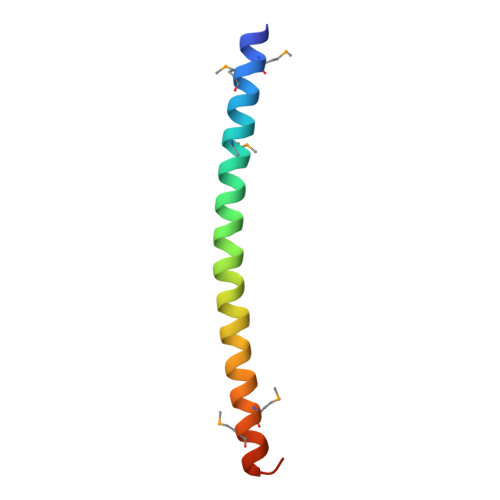Architectural basis for cylindrical self-assembly governing Plk4-mediated centriole duplication in human cells.
Il Ahn, J., Zhang, L., Ravishankar, H., Fan, L., Kirsch, K., Zeng, Y., Meng, L., Park, J.E., Yun, H.Y., Ghirlando, R., Ma, B., Ball, D., Ku, B., Nussinov, R., Schmit, J.D., Heinz, W.F., Kim, S.J., Karpova, T., Wang, Y.X., Lee, K.S.(2023) Commun Biol 6: 712-712
- PubMed: 37433832
- DOI: https://doi.org/10.1038/s42003-023-05067-8
- Primary Citation of Related Structures:
7W91 - PubMed Abstract:
Proper organization of intracellular assemblies is fundamental for efficient promotion of biochemical processes and optimal assembly functionality. Although advances in imaging technologies have shed light on how the centrosome is organized, how its constituent proteins are coherently architected to elicit downstream events remains poorly understood. Using multidisciplinary approaches, we showed that two long coiled-coil proteins, Cep63 and Cep152, form a heterotetrameric building block that undergoes a stepwise formation into higher molecular weight complexes, ultimately generating a cylindrical architecture around a centriole. Mutants defective in Cep63•Cep152 heterotetramer formation displayed crippled pericentriolar Cep152 organization, polo-like kinase 4 (Plk4) relocalization to the procentriole assembly site, and Plk4-mediated centriole duplication. Given that the organization of pericentriolar materials (PCM) is evolutionarily conserved, this work could serve as a model for investigating the structure and function of PCM in other species, while offering a new direction in probing the organizational defects of PCM-related human diseases.
- Cancer Innovation Laboratory, Center for Cancer Research, National Cancer Institute, National Institutes of Health, Bethesda, MD, 20892, USA.
Organizational Affiliation:

















